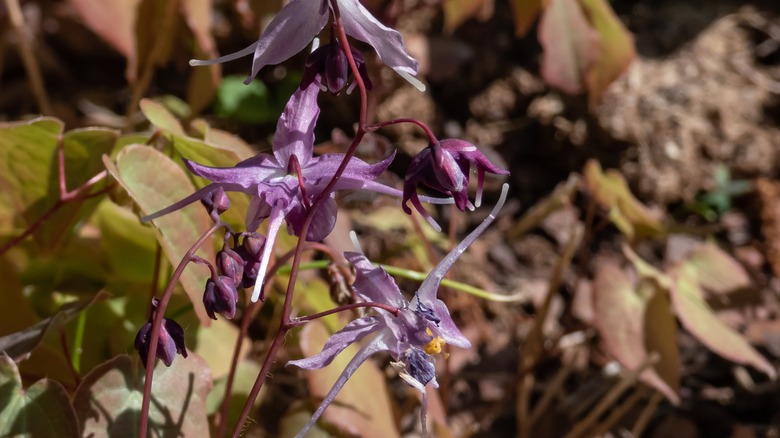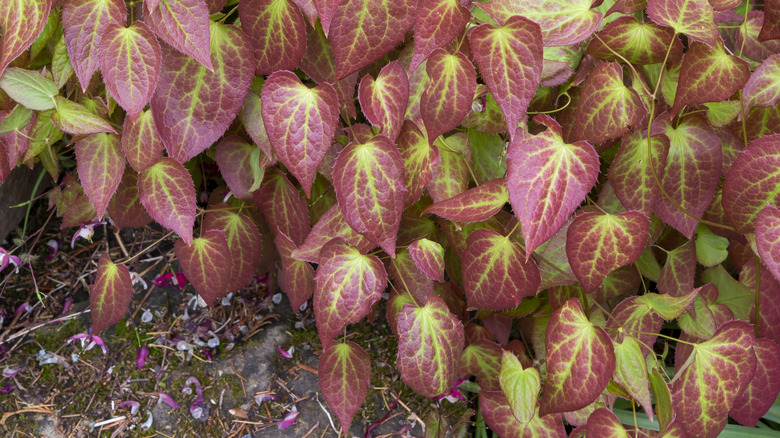The Perfect Ground Cover For Tree Roots That Produces Delicate Pink Flowers
The unsightly cost of having big, beautiful trees in your landscape is often ugly exposed tree roots. One excellent way to spruce up the area under your trees to hide those roots and add a pop of color is to plant shade-friendly, easy-to-grow ground cover plants like epimedium, which thrives in the shade and features gorgeous pink-toned leaves with green veins underneath delicate pink flowers. Often referred to as barrenwort, bishop's hat, or fairy wings, Epimedium grandiflorum is an evergreen flowering plant that's a bit slow to establish but worth planting in the long run. Once mature, this plant spreads on its own to fill any shady space and blooms from March to May, offering dainty flowers reminiscent of tiny fairy wings, hence its popular nickname.
Native to regions of China, with a few species originating in the Mediterranean, epimedium has been planted and cultivated by gardeners for over 150 years for its ability to grow in harsh conditions. While pink is the most common flower color, it's also available in cultivars that bloom in shades of yellow, white, purple, and red. There's no shortage of variety if you'd like to plant a few different types for a mixed-color effect.
How and when to plant epimedium as a ground cover
Epimedium grows well even in dry shade, making it a low-maintenance option for landscaping around exposed tree roots that don't get much irrigation. Its shallow rhizomes can also grow over the top of existing tree roots. When choosing your location, be sure to examine the soil. This plant prefers a well-draining, acidic soil heavy in organic matter, much like you would find on a forest floor.
It's best to plant in late fall, from October to November, or early spring, no sooner than March. When planting, try to space out the plants so that you have 1 foot of space between each plant, allowing enough room for each plant to spread out naturally. This way, even though epimedium is typically a slow grower, you'll get the ground cover effect in the first couple of years. After the plants are established, division can be done every three to four years. While it's not a necessity, division is a practice that can help epimedium grow more quickly. It not only increases the number of plants you have but also creates more space for new growth on your existing plants. Do this in the spring or fall to see new blooms flourish after planting.
How to care for epimedium plants
After planting, epimedium blooms in the spring. This is a great time to remove any tattered and damaged leaves that helped protect the plant over the cold season. Doing so helps to promote new leaf growth, as does a little fertilizer. You can apply a slow-release fertilizer in March, though this often isn't necessary unless your epimediums live under a tree with a large root system that absorbs most of the nutrients from the soil.
Each year, a mulch of standard compost will also do the trick with the added bonus of keeping weeds at bay; plus, it's cheap and easy to make your own DIY compost. During the coldest parts of winter, newly planted epimedium plants can benefit from a layer of mulch to help protect them from frost. If you're not sure if there are enough nutrients in your soil to support epimedium plants, you can use a soil testing kit to find out what minerals it lacks. Other than light, easy pruning, and fertilizing, epimedium needs little further care — except during the summer heat. When the weather gets very warm, be sure to offer them a little extra water to help them stay healthy.


